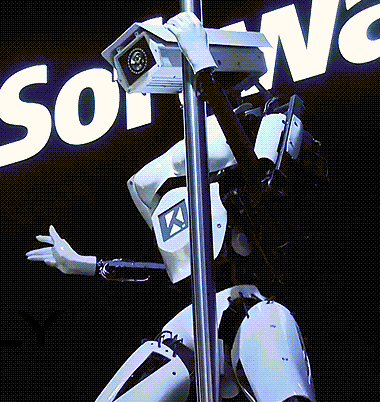For those of you back in 1985 who thought that, by now, we would have flying cars, Marty McFly’s shoes and the cure for cancer, I hereby announce that we, dear people, have invented something absolutely indispensable. We’ve now got…
Pole-dancing robots!
You read right! Steel robots have never been sexier!
You might be asking yourself why do we need a robot who does pole-dancing. Apart from being an awesome art piece, what is the applicability of such dancers?
The robots are an invention of British artist Giles Walker, who created them back in 2008. In fact, there are actually two pole-dancing robots, and a third companion who works as a DJ.
Walker explained that the robots were not developed with the intention of stealing anyone’s jobs or making a statement about robotics and job automation. Rather, they are all about surveillance.
“At the time, they were putting CCTV cameras up all around London, and Britain was becoming the most surveyed society in the world”, explained Walker.
Walker: I was playing with this idea of voyeurism, and who has the power in that relationship; whether it’s the voyeur or the person being watched.
He added that there was a lot of discussion in the news at the time about the ‘sexed up’ Iraq dossier, when the British government published a document examining the existence of WMDs in Iraq.
Therefore, if a document could be sexed up, Walker thought, maybe surveillance cameras could be as well. “That’s how I got to these mechanical peeping toms. It was a mingling of all those things.”
Since their development, the robots have become more and more popular. Walker usually hires them out to tech conferences, festivals, and other events, such as the 2012 CeBIT trade fair in Hanover, where they caused a commotion. They cost around $1,343 a day.
The robots are not technologically complex. They are, instead, shop mannequins. Windscreen wiper motors provides them with power and short, predefined loops control their movements.
A politically correct art piece?
I shall not forget to mention the ethical issues these art pieces entail. As a feminist and regular attendee of tech conferences, these pole-dancing robots feel outrageously dated.
In the famous words of British writer Jane Austen: “It is a truth universally acknowledged that the tech industry is a haven for sexist demonstrations”. No wonder the evident lack of women who occupy relevant positions in the industry.
Some might consider sexualized robots at tech conferences as an example of the ‘bro culture’ that has, in part, contributed to these issues.
As a result, Walker says he would definitely rethink the robots’ functionality. No doubt, the rise of ‘sexbots’ has given the sculptures new connotations.
While we try to deal with these ethical issues, one question remains. Do pole-dancing androids dream of robot employment rights?


